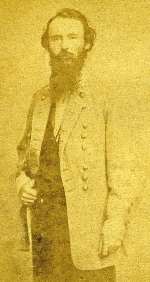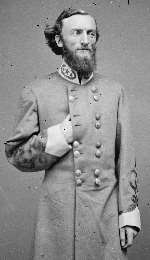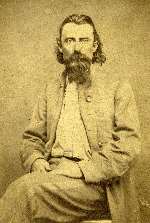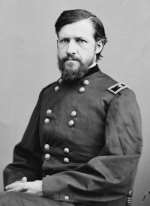Search:
Powered by
Website Baker
Price Invades Missouri
Price named his invasion force the Army of Missouri, consisting of about 12,000 cavalry, although Price reported to headquarters that 4,000 of them were unarmed. The army included 14 pieces of field artillery. There were three divisions commanded by Major General James F. Fagan, Major General John S. Marmaduke and Brigadier General Jo Shelby. Leaving from Pocahontas, Arkansas, Price’s army entered Missouri on September 19, 1864.
|
James F. Fagan courtesy of the Wilson’s Creek National Battlefield, National Park Service |
John S. Marmaduke courtesy of the Library of Congress |
Jo Shelby courtesy of the Wilson’s Creek National Battlefield, National Park Service |
|
Thomas Ewing, Jr. courtesy of the Library of Congress |
Price was headed for St. Louis, but decided to deal with the Federals under Brigadier General Thomas Ewing, Jr. at Fort Davidson. It was going to be a simple matter of destroying the small force of 1,200 located in Pilot Knob, Missouri.
While Shelby roamed north with his division destroying railroad terminals and bridges, Price moved on Fort Davidson with Marmaduke’s and Fagan’s Divisions. After Ewing withdrew the Federals inside of the fort, Price launched an unsuccessful attack against the earthworks on September 27. Now the Confederates surrounded and trapped the Federals inside Fort Davidson. But after midnight, the Federals were able to evacuate the fort and escape. Price ordered some of his forces to chase after the Federals, but their pursuit was unsuccessful.
Now Price turned his attention to St. Louis. But when he moved north towards the city, Price discovered it was too well defended to attack. So Price turned west, setting his sights on Jefferson City. The Army of Missouri moved slowly west, collecting plunder and destroying infrastructure. The Confederates reached the outskirts of Jefferson City on October 6. Once again, Rosecrans had time to mobilize reinforcements, and Price decided not to attack Jefferson City. Brigadier General John B. Sanborn was the Federal commander in Springfield when he received orders from Rosecrans to mobilize his cavalry. Sanborn described the movements in his official report.
"On the 27th day of September, pursuant to a telegraphic order from the general commanding, dated September 26, 1864, I moved with all my available cavalry force in the direction of Rolla, leaving a sufficient force at [Springfield] to make it reasonably secure. I arrived at Rolla with my command, consisting of about 1,500 cavalry, at 3 p.m. on the 29th, making the entire distance of 120 miles in fifty-eight hours.
"On the evening of October 1 information was received that General Ewing and his command were at Leasburg, hard pressed by the enemy … [On October 3, I] learned that the entire force of the enemy [was moving] in a northwest direction [towards Jefferson City] … I moved with my command at daylight the next day … and reached Jefferson City in thirty-six hours after leaving Cuba, a distance of about eighty miles, crossing the ford on the Osage but a few hours before the enemy."
Next Price moved upriver, occupying Boonville on October 11. Now that Jefferson City was safe, Rosecrans ordered his second in command, Major General Alfred Pleasonton, to assume command of the Federal cavalry and take out after the Confederate army. Pleasonton planned to “proceed as a corps of observation after the enemy, to harass and delay him as much as possible until other troops could be brought forward.”
Many civilians living in Boonville were sympathetic to the Southern cause. Price described how well his men were treated during the three days he stayed in Boonville.
"My reception was enthusiastic in the extreme. Old and young, men, women, and children, vied in their salutations and in ministering to the wants and comforts of my wearied and war-worn soldiers."
Upon leaving Boonville, Price continued moving his army west towards Kansas City. Shortly after leaving Boonville, Price sent one detachment from his army upriver to attack Glasgow, Missouri. Price sent another detachment west to attack Sedalia. Both these attacks occurred on October 15 and were successful. The two detachments rejoined the Army of Missouri as it continued its march west, now heading for Lexington, Missouri.



